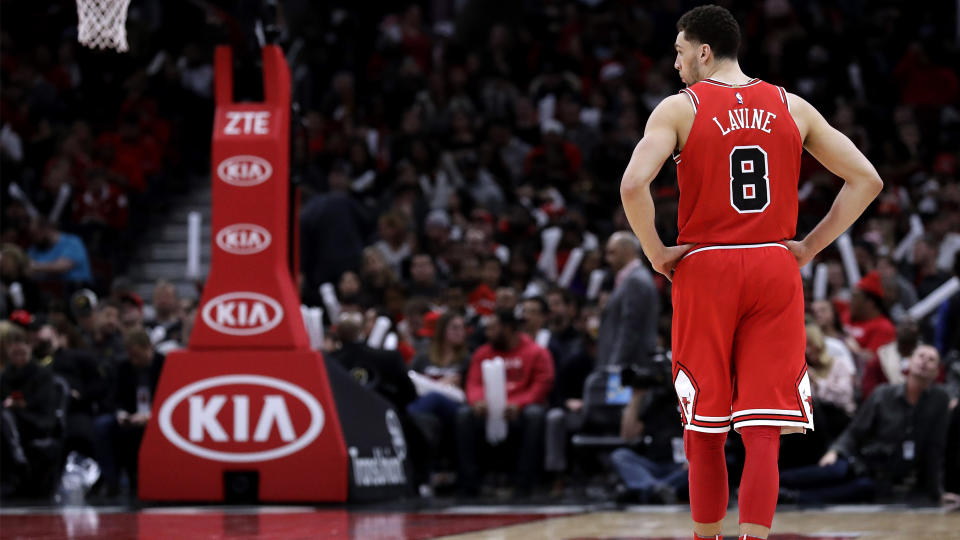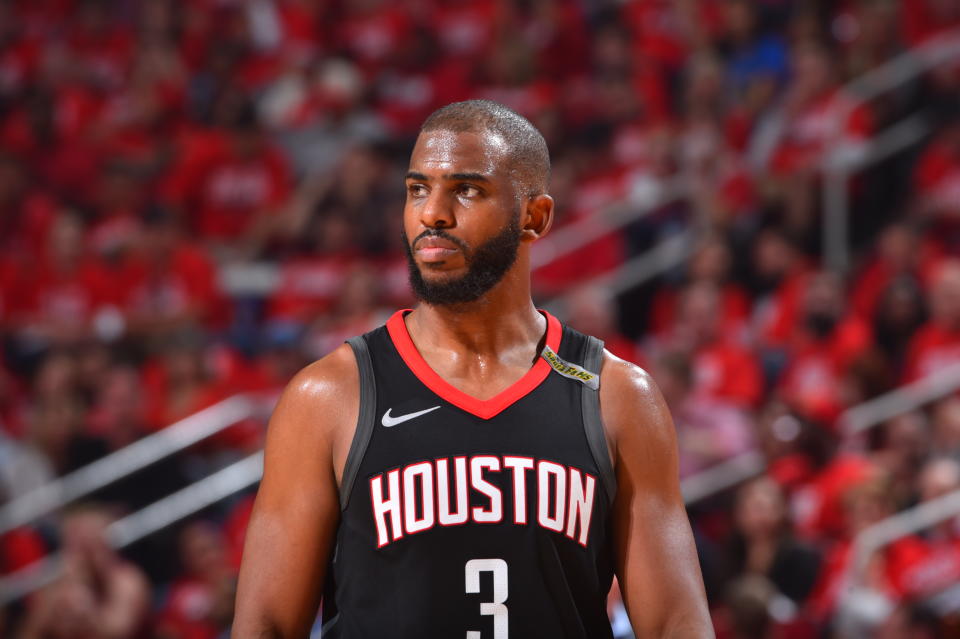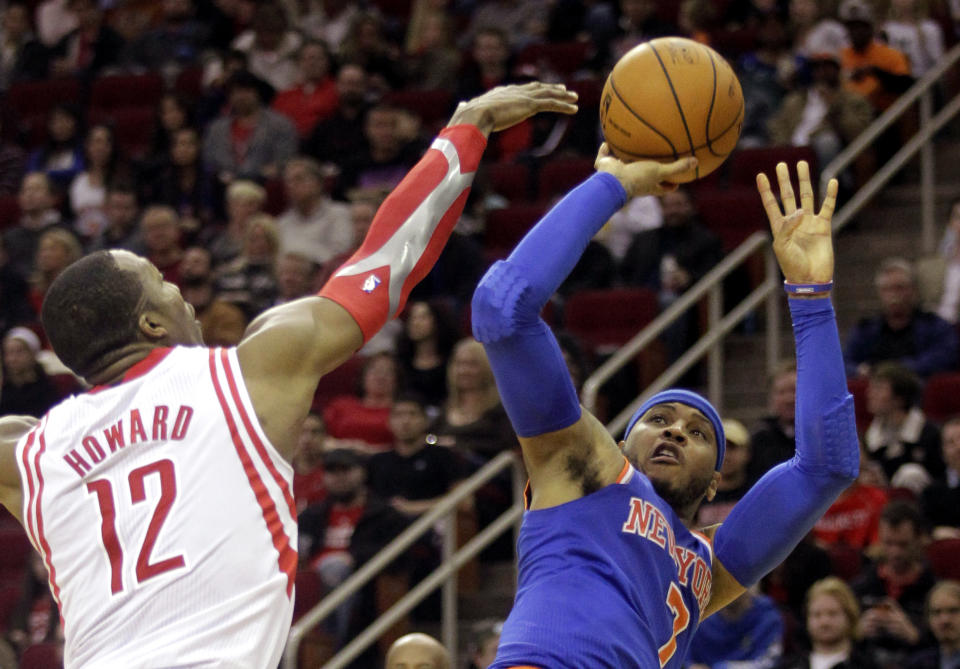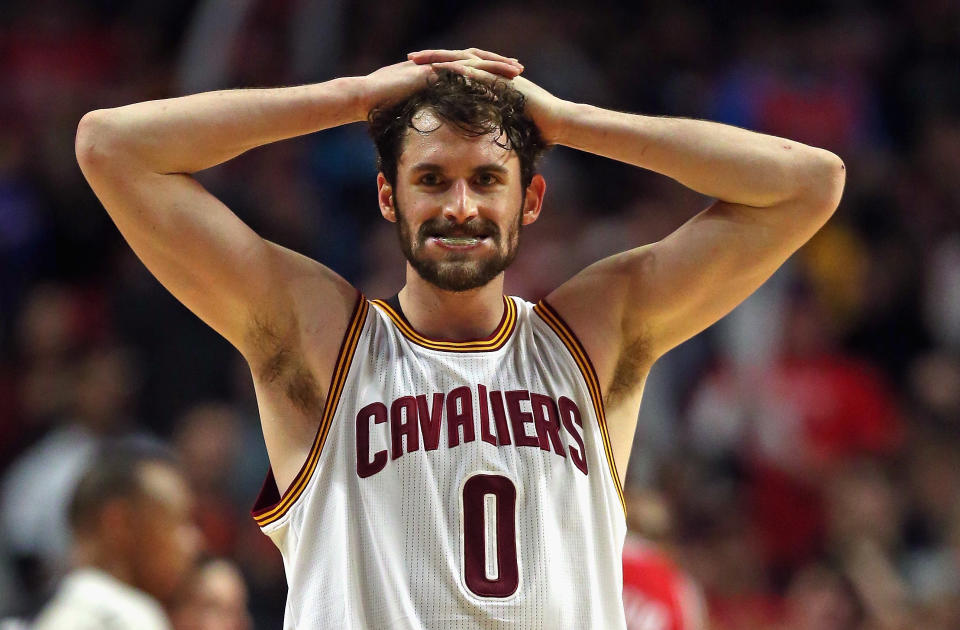The five biggest boom-or-bust moves of the 2018 NBA offseason
Every summer, a number of NBA teams find themselves facing big roster-management decisions that will determine the makeup of their squad, and potentially the viability of their path to meaningful contention, for years to come.
Get them right — like, say, the Warriors moving heaven and earth (and Andris Biedrins, Richard Jefferson, Brandon Rush and five draft picks) to land Andre Iguodala in the summer of 2013 — and you could set yourself up to be a major player for a half-decade. If they break the other way, though — like, say, the Blazers spending $226 million in the summer of 2016 on Evan Turner, Allen Crabbe, Meyers Leonard and Mo Harkless — you might find yourself stuck in neutral and scrambling for new solutions sooner than you’d expected.
As the 2018-19 NBA season draws nearer, let’s take a look at some of this past summer’s choices with the biggest boom-or-bust potential, starting out in Arizona:

The Suns going all in on Devin Booker
It’s genuinely baffling that I’m not sure if saying “I think Devin Booker is good” is, like, a take.
Figuring that out requires examining the buffet of opportunities he’s gotten as the Phoenix Suns’ top scoring threat for most of his first three seasons, and considering how much his production in that role matters, given the context of just how dreadful those Suns teams have been. It also means balancing the awareness that defense matters with the acknowledgment that elite offensive creation — or at least the chance for it, buttressed by supporting evidence — probably matters more.
Reasonable people can come to different conclusions after weighing all that out. I tend to land on the side that thinks we should be less wary of the possibility that Booker’s nothing more than an empty-calories scorer on teams that can’t go anywhere, and more impressed by him being one of only four players ever to average at least 24 points, four rebounds and four assists per game by his age-21 season (the other three: LeBron James, Michael Jordan, Tracy McGrady) and being one of just eight that young to use more than 30 percent of his team’s offensive possessions while posting a True Shooting percentage north of .550 (the other seven: LeBron, Carmelo Anthony, Kevin Durant, Kobe Bryant, Kyrie Irving, Shaquille O’Neal and pre-injury Derrick Rose).
The Suns have something in Booker, a 6-foot-6 gunner who drilled catch-and-shoot 3s at virtually the same clip as Kevin Love last season and pull-up bombs at the same rate as LeBron James and Damian Lillard. Booker responded to a significant increase in his offensive role last season by bumping his assist rate while keeping his turnover percentage steady. He filled his team’s post-“I Dont want to be here” playmaking void by developing into an increasingly proficient pick-and-roll ball-handler. He’s looked for three years like virtually the only thing worth celebrating in Phoenix.
And so, the Suns celebrated him, to the tune of a five-year contract extension worth $158 million: the maximum salary possible as Booker enters his fourth pro season, locking him up as a cornerstone to pair with No. 1 overall pick Deandre Ayton in leading the next era of Phoenix basketball.
The max is a bet that Booker, as he approaches his athletic prime, will evolve into one of the two or three best shooting guards in the league. It’s a bet that there’s nothing worth worrying about in the fact that he missed the final 12 games of last season with a sprained right hand — the one he shoots with — and then needed surgery on that same mitt after a summer of Team USA and individual workouts left it swelled up and stinging. (Or, at least, that what’s most worrying about Booker’s hand injury is the way the Suns handled its aftermath.)
It’s a bet that, with more talent on-side in a more disciplined environment under new head coach Igor Kokoskov, a player with Booker’s talents and smarts can develop into a passable defender and a credible on-court leader — the kind of organizing principle and galvanizing force that can elevate a fun young team into legitimate postseason contention.
It’s still a bet, though, and wagers carry risk. The Suns have staked their future on the proposition that Booker’s got an All-NBA ceiling, the physical and mental tools to reach it, and the capacity to bring the rest of the roster with him. If they’re right, we might not be too far away from seeing playoff basketball in Phoenix for the first time in a decade. If they’re wrong, things might stay dark in the Valley of the Sun for a long, long time.
The Bulls matching Zach LaVine’s offer sheet
Evidently, your man Zach knew what he was talking about when he hit Nick Friedell with an undercutting emoji after seeing the ESPN reporter’s take on his market in restricted free agency:
😂
— Zach LaVine (@ZachLaVine) July 1, 2018
The UCLA product wound up landing a significantly richer deal — four years, $78 million — thanks to the unbridled kindness of the Sacramento Kings and the Chicago Bulls’ unwillingness to let one of the big pieces of the Jimmy Butler deal walk for nothing. Take that, Nick!
Whether or not any other team would’ve offered that much, Sacramento did and Chicago matched, a decision that left LaVine thanking God. It also left the Bulls committed to paying $19.5 million a season to a player who’s been broadly considered one of the league’s worst defenders when healthy, and who’s evinced a lack of polish when it comes to executing both fundamentals and finer points of team offense. That combination has helped contribute to LaVine’s teams posting a worse point differential with him on the court than off it in each of his four professional seasons.

Now, some 19 months removed from the ACL tear that limited him to just 71 games over the last two years, LaVine appears to have his burst and bounce back. If that translates into a spike in his shooting efficiency — a career-low .442 Effective Field Goal percentage on a career-high 19.5 shots per 36 minutes last season, a rare combination of bold and bricky last turned in by post-Achilles-tear Kobe Bryant — as well as a more attentive application of his athletic gifts on the defensive end, then LaVine may well resume his injury-interrupted development into one of the game’s more exciting young finishers.
Even if he does, though, major questions remain about how well that kind of shoot-first, slashing, secondary playmaker will fit into the framework of a potentially interesting Bulls team featuring the need-to-be-fed mouths of Lauri Markkanen and Jabari Parker. If LaVine doesn’t show signs of significant improvement in the non-scoring areas of his game, he might top out as an instant-offense, change-of-pace sixth man type … which isn’t exactly the sort of thing a rebuilding club should be spending $78 million on into the 2020s.
The Raptors gambling on one year of Kawhi Leonard
As I wrote after Masai Ujiri took his big swing, the deal made all the sense in the world for Toronto. The Raptors got a prospective top-five player, and it cost them a very good but not great player who’s still got $83.2 million left on his contract in DeMar DeRozan, a solid young center in Jakob Poeltl, and what will either be a first round pick somewhere in the 20s or two second-rounders. And if Leonard either doesn’t return to his MVP-caliber two-way heights after missing all but nine games of last season with a persistent quadriceps injury, or elects to skate to Southern California at his first opportunity next summer, then the Raptors still remain in position to reboot in a hurry, which would’ve been considerably more difficult with DeRozan’s $27.7 million on the books through 2021.
The risk is mitigated, hedged — squarely within acceptable margins when the potential reward is the best player Toronto has ever employed. But there is risk.
In pursuit of heights they’ve never before reached, the Raptors dismissed two core pieces — DeRozan and head coach Dwane Casey — of their best teams ever, calling an end to an era of sustained success unlike anything the fledgling franchise had seen. That loss might not wind up feeling so painful if a Kawhi-led squad wins it all and he sticks around, or if a post-Kawhi rebuild results in the new nucleus of a team that can consistently advance beyond the second round. Something did get lost, though. All that’s left is to find out how much.
The Rockets maxing out Chris Paul through age 36
We knew this was coming ever since Paul orchestrated his way to Texas last summer. You don’t give up four rotation players and a first-round pick to get somebody and then just let him walk a year later.
And it was, on balance, really the only thing for Houston to do. When you stomp the league for 65 wins and get within one hamstring pull and one record-setting long-distance ice storm of knocking off the team that dominates the sport, you do whatever’s in your power can to run it back. That includes lavishing a four-year, $160 million contract on the point guard who made the Rockets murderous and helped propel James Harden to his first MVP trophy.
You pay players like Chris Paul because, well, there just aren’t players like Chris Paul — that ferocious, that precise, that gifted in all phases of the game, that talented at putting teammates precisely where they need to be to succeed and at short-circuiting the opponent’s game plan. You can argue, if you’re so inclined, that the Rockets actually came away a winner here, by getting CP3 on-board with a four-year agreement rather than pushing for the full-boat five-year, $205 million max many expected he’d command.
And yet.

We’re talking about a 6-foot-tall point guard who has 13 years and nearly 35,000 NBA minutes of wear and tear on his body. One who has undergone surgery to repair a torn meniscus, a broken hand and a torn thumb ligament. One who has dealt with debilitating hamstring injuries and missed significant time to a separated shoulder. One who has missed at least 20 games in three of the last four seasons, including each of the past two, and who will be 33 years old when he begins a new four-year deal that includes a $44.2 million player option for the 2021-22 season, his age-36 campaign.
When the Rockets re-upped Harden on his own mega-max extension before last season, they did so with the goal of locking down a foundational piece for his entire expected prime, and of ensuring that other superstars knew that Harden would be on hand to contend for years. That certainty helped prompt Paul to make his way to Houston, and it got the Rockets as close to a championship as they’ve been since Hakeem left town. You don’t just throw that away. A couple of years down the line, though, the Rockets might find themselves feeling the pain of the high cost of doing championship-level business.
Rolling the dice on Dwight Howard and Carmelo Anthony
From a financial perspective, these two moves are just about risk-free. It cost the Washington Wizards just over $5.3 million (plus a $5.6 million player option for next year) to bring in Howard after the Charlotte Hornets traded him and the Brooklyn Nets waived him. The price tag on Anthony was even lower for the Houston Rockets — just the veteran’s minimum of $2.4 million, with the NBA actually reimbursing Houston for nearly $900,000 of that outlay, a quirk in the collective bargaining agreement aimed at steering teams away from avoiding older vets just because their accrued service time makes their minimum deals more expensive than the ones younger players can get.
In a cash-flush league where the average player salary now sits at nearly $7.5 million, landing rotation-minutes contributors at positions of need for less than that seems like a bargain for teams harboring postseason aspirations. But basketball’s about more than balance sheets, and these two future Hall of Famers were on the market for a reason.

Even after averaging 16.6 points, 12.5 rebounds and 1.6 blocks in 30.4 minutes per game over 81 starts last season, Howard was available for the Wizards because the Hornets were reportedly so eager to extricate him from their locker room that they flipped his expiring contract to Brooklyn — even if it meant taking back two years and $32.7 million worth of Timofey Mozgov — and because the Nets had no interest in keeping him around. Anthony made his way to Houston because he struggled through his lone season in Oklahoma City, playing the least productive basketball of his career in a tertiary role behind Russell Westbrook and Paul George while also proving a damaging defensive liability. And because the Thunder desperately wanted to shed his mammoth contract to slash a gigantic luxury tax bill, and because Atlanta viewed him as ostensibly a headband-wearing makeweight to effectively offload Dennis Schröder.
They’re not what they once were, with years of hard-driven NBA mileage having chipped away at the athleticism and aptitude they showcased during the days when they were filling their trophy cases. They’re still capable of making positive contributions for their new teams, but doing so could require changes in self-image that two such accomplished and proud players might be loath to make.
Even 14 years in and on his fourth team in four years, Howard could be exactly what Washington needs to return to the ranks of the Eastern Conference’s elite if he’d commit to playing to his strengths: protecting the rim, cleaning the defensive glass and running the floor in transition, setting stiff screens, rolling hard to the basket, sucking in defensive attention, and finishing lobs and putback opportunities. And yet, Howard has resisted what he feels is too narrow a definition of his talents for years, and made noise this summer about evolving his game outward, a la Anthony Davis and Kevin Durant, rather than focusing it inward. If Dwight again bristles at playing a circumscribed role and insists on stepping out into the spotlight, D.C.’s new chemistry experiment — already an interesting trial, given the presence of possible spark-throwers John Wall, Bradley Beal and Markieff Morris, and the arrival of the pugnacious Austin Rivers — could blow up in everyone’s face.
Similarly, Anthony could offer a bankable third option to reduce the point-producing load on Harden and Paul, giving Houston a third isolation scorer who can hit midrange jumpers come the postseason, when defenses tighten up and take away the Moreyball shots the Rockets like best. Anthony scuffled mightily in adjusting to that kind of role in Oklahoma City, though, and his defensive shortcomings cost the Thunder dearly in their opening-round playoff loss to the Utah Jazz.
The Rockets’ two top guns have insisted that they’ll be able to get the best out of Anthony, and head coach Mike D’Antoni has expressed optimism that this go-round with ‘Melo will turn out better than the last one. But if Anthony follows up the worst season of his career with another year of deteriorating production — if he’s unable to pull his weight as a replacement for the likes of Trevor Ariza and Luc Mbah a Moute, and again unwilling to consider a redefinition of his role that might include a move out of the starting lineup — then it’s hard to see him helping make Houston better, or playing a meaningful role in a matchup against Golden State. And given the stakes the Rockets are playing for, any move that reduces your likelihood of reaching the top of the mountain could prove costly, even if it’s not especially expensive on paper.
Four more big decisions that could break big or break bad

• Kevin Love’s new contract: On one hand, locking down the lone remaining All-Star from the 2016 championship team was a logical and defensible response for a Cleveland Cavaliers team that had just lost LeBron again, that was not interested in plummeting to the bottom of the NBA like they did the last time he left, and that wanted to make sure 2018 lottery pick point guard Collin Sexton had a pick-and-pop partner to work with as he acclimates to running the show at the NBA level. On the other, the final two years and $60.2 million of this extension might wind up looking a bit steep for the age-33 and -34 seasons of a player who has missed 45 games due to knee, back and hand injuries over the past two years and has had multiple concussion scares, especially if his continued presence can’t even guarantee that Cleveland stays in playoff contention in a watered-down East.
• The Nuggets drafting Michael Porter Jr.: In a vacuum, getting a potential No. 1 pick talent — a 6-foot-10, 215-pound three-level scoring forward — with the 14th selection in the draft is cause for a host of hosannas. Picks don’t happen in a vacuum, though, and the fact that Porter plummeted due to concerns about his surgically repaired back and spasming hip matters. As does the fact that he had a second spinal surgery weeks after the draft, putting him on the shelf indefinitely and at least raising the possibility that he’ll sit out his entire rookie season.
Having a freshman year curtailed by injury wouldn’t doom Porter to fizzling out. Blake Griffin, Joel Embiid, Ben Simmons and a slew of other players have battled through early-career injuries to shine, and if Porter can do the same, he could further fortify a Denver team that appears poised to field a terrifying offense. But if Porter’s back never returns to 100 percent, and he’s incapable of being the sort of game-breaker he was expected to be entering Missouri, then the Nuggets — now capped out for two years after big deals for Paul Millsap, Nikola Jokic, Gary Harris and Will Barton, with the clock ticking on Jamal Murray’s rookie deal — could rue taking a big shot on a big talent with a big red flag.
• The 76ers doing basically nothing: The Sixers entered the offseason riding high after a 52-win season led by two of the sport’s most exciting young talents, with the cap space and trade assets to go “star-hunting” in pursuit of a championship. They enter training camp with more or less the same roster — vaya con dios, Ersan Ilyasova and Marco Belinelli; welcome aboard, Wilson Chandler, Jonah Bolden and Mike Muscala — and without having gotten close to landing big fish like James, Leonard or George.
Elsewhere, the Celtics got healthy, the Raptors got Kawhi, and the Bucks got Giannis a coach. In Philly, top draft pick Zhaire Smith got acquainted with the devious witch who haunts Sixers rookies, and nobody got the GM job.
None of that necessarily means Philly’s been lapped in the East, especially if the Sixers’ many young talents — Embiid, Simmons, Dario Saric, Robert Covington, hopefully reprogrammed 2017 No. 1 overall pick Markelle Fultz — all take the sorts of steps forward that Brett Brown and company expect. But with extensions for Embiid and Covington kicking in this year, Saric becoming extension-eligible next summer, and the option-year cap hits for former No. 1 picks Simmons and Fultz rising fast, Philadelphia needs to make hay while the sun’s out. By standing pat this summer, the Sixers allowed their undeniably bright future to get just a bit dimmer.
• Everything the Lakers did after they signed LeBron: I don’t know, man. That roster still looks weird to me, even if it’s the result of a carefully orchestrated plan crafted by a beautiful mind and one of the headiest playmakers the sport’s ever seen.
Maybe it doesn’t really matter. Maybe because nothing else L.A. did this summer compromised their plan of landing another bona fide superstar next summer — and, in fact, only improved the Lakers’ odds, thanks to jettisoning Luol Deng to carve out even more salary cap space — the run of strange-seeming and ill-fitting one-year deals will be forgotten as soon as Magic Johnson and Rob Pelinka land that next big fish.
There’s a downside there, though: the chance that the Lakers don’t land their first or second max-level choice, that the results of the wheeling and dealing pale in comparison to the fans’ and front office’s mega-marquee dreams, and that L.A. winds up having wasted a year of LeBron’s prime (maybe one of the last?) by being too clever by half.
Getting LeBron was a feat in its own right, but it’s only the start of a larger project. We might have to wait until next summer to find out whether the actions of this one set it up to be a success, or made it more likely to fail.
– – – – – – –
Dan Devine is a writer and editor for Yahoo Sports. Have a tip? Email him at devine@yahoosports.com or follow him on Twitter!


